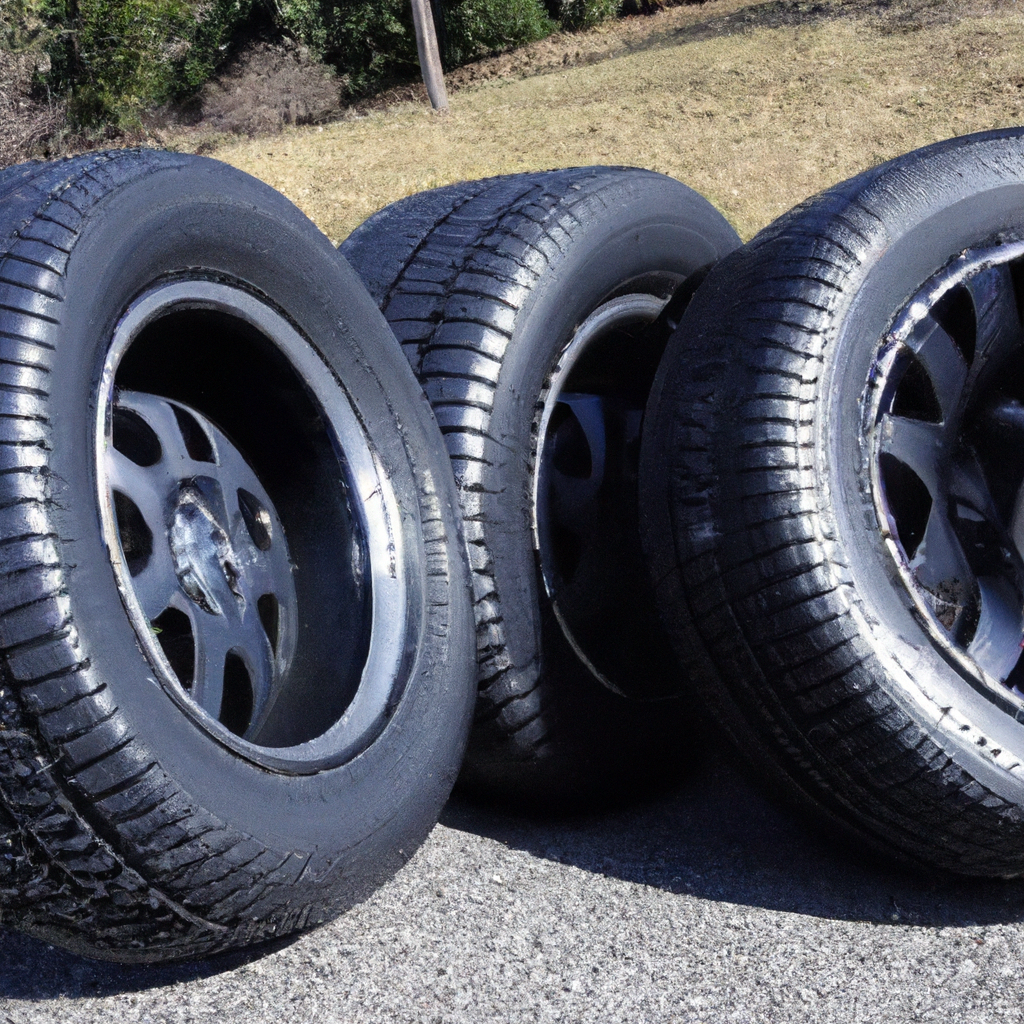If you find yourself residing in an area where temperature fluctuations can seem like a wild rollercoaster ride, you may wonder if run-flat tires are suitable for such conditions. With their unique ability to tolerate punctures and allow you to keep driving for a limited distance, run-flat tires offer convenience and peace of mind. But, are they equipped to handle the challenges posed by extreme temperature changes? In this article, we will explore this question and provide you with valuable insights to help you make an informed decision for your vehicle.
What are run-flat tires?
Definition of run-flat tires
Run-flat tires, also known as self-supporting tires, are designed to allow you to continue driving safely for a limited distance even after a puncture or loss of air pressure. Unlike traditional tires, run-flat tires are built with reinforced sidewalls that can temporarily support the weight of the vehicle in case of tire failure. This feature eliminates the need for immediate tire change or the use of spare tires, providing drivers with added convenience and peace of mind.
How run-flat tires work
Run-flat tires are specifically engineered to withstand the weight of the vehicle even when air pressure is lost. This is made possible by the reinforced sidewalls, which are designed to temporarily support the weight of the vehicle and maintain its stability. The strength of the sidewalls allows the tire to stay mounted on the rim, preventing it from slipping off in case of a puncture.
In the event of a tire puncture, run-flat tires can typically provide a driver with the ability to continue driving for up to 50 miles at a reduced speed. This allows you to reach a safe location or a tire service center without needing to immediately change your tires. It is important to note that the maximum distance and speed the tire can handle after a puncture may vary depending on the specific tire model and manufacturer.
Effects of extreme temperature changes on tires
Temperature fluctuations in extreme climates
Extreme temperature changes can have a significant impact on the performance and longevity of tires. In areas with extreme heat, such as deserts or hot summer climates, the elevated temperatures can cause the tire pressure to increase, potentially leading to overinflation. On the other hand, extremely cold temperatures can cause the tire pressure to decrease, leading to underinflation.
Impact on tire performance
Temperature changes can affect various aspects of tire performance. In hot weather, overinflated tires can result in reduced traction, handling, and braking efficiency. Over time, excessive heat can also cause the tire compound to degrade, leading to reduced tread life and increased risk of blowouts. In cold weather, underinflated tires can become stiff and less flexible, resulting in decreased traction and reduced responsiveness.
Potential risks and damages
Extreme temperature changes can pose risks and potentially damage non-run-flat tires. Underinflated tires in hot weather can become more prone to blowouts, while overinflated tires can experience sidewall and tread damage. In cold weather, underinflated tires can develop flat-spotting and even experience tire bead dislocation from the rim. These risks can lead to accidents, unexpected breakdowns, and additional expense for tire replacements.

Advantages of run-flat tires in extreme temperature changes
Improved safety in case of tire failure
One of the key advantages of run-flat tires in areas with extreme temperature changes is the improved safety they provide in the event of a tire failure. In the case of a sudden puncture or loss of air pressure, run-flat tires allow you to maintain control of your vehicle and continue driving to a safe location without the need for an immediate tire change.
Reduced risk of accidents
The ability to continue driving on run-flat tires after a puncture or loss of air pressure reduces the risk of accidents that may occur in the process of changing a tire on the side of the road. This is particularly important in extreme temperature conditions where the safety of the driver and passengers can be compromised by exposure to excessive heat or cold.
Convenience and peace of mind for drivers
Run-flat tires offer the convenience of not having to carry a spare tire or the tools required for a tire change. This can be especially beneficial in areas with extreme temperature changes, where stopping to change a tire can be uncomfortable or even dangerous. Additionally, the peace of mind provided by run-flat tires allows drivers to continue their journeys without worrying about finding a tire service center immediately.
Factors to consider when using run-flat tires in extreme temperature changes
Tire manufacturer recommendations
It is important to consider the recommendations of the tire manufacturer when using run-flat tires in areas with extreme temperature changes. Manufacturers provide guidelines regarding the maximum speed and distance you should travel on a run-flat tire after a puncture or loss of air pressure. Adhering to these recommendations ensures optimal performance and safety.
Tire pressure monitoring systems
To ensure the proper functioning of run-flat tires, it is crucial to have a functioning tire pressure monitoring system (TPMS) in your vehicle. TPMS allows you to continuously monitor the tire pressure and receive alerts in case of any abnormalities. This enables you to address any issues promptly and prevent potential damage or hazards caused by improper tire pressure.
Specific tire models and their temperature limitations
Different run-flat tire models may have varying temperature limitations. Some run-flat tires may perform better in extreme heat, while others may be more suitable for extreme cold conditions. It is important to research and choose a run-flat tire model that is designed to withstand the specific temperature ranges you anticipate encountering in your geographical area.

Compatibility of run-flat tires with extreme temperature changes
Research on run-flat tire performance in different climates
Researchers and tire industry professionals have conducted studies on the performance of run-flat tires in different climates. These studies have shown that run-flat tires generally perform well in extreme temperature changes, provided they are used within the manufacturer’s guidelines and recommendations.
Specific temperature ranges for optimal performance
Run-flat tires are designed to operate in a wide range of temperatures. However, it is important to note that extreme temperature fluctuations can still impact their performance. It is recommended to avoid prolonged use of run-flat tires in temperatures exceeding the recommended limits specified by the tire manufacturer. Staying within the recommended temperature ranges ensures optimal performance and longevity.
Climate considerations when selecting run-flat tires
When selecting run-flat tires for use in areas with extreme temperature changes, it is crucial to consider the specific climate conditions you expect to encounter. Determine whether you will be primarily driving in hot, cold, or a combination of both environments. This will help you choose a run-flat tire model that is best suited to withstand the particular climate challenges you may face.
Maintenance tips for run-flat tires in areas with extreme temperature changes
Regular tire inspections and maintenance
To ensure the optimal performance and longevity of run-flat tires in areas with extreme temperature changes, it is essential to conduct regular tire inspections and maintenance. This includes visually inspecting the tires for any signs of damage or wear, checking the tire pressure regularly, and rotating the tires as recommended by the tire manufacturer.
Proper tire inflation
Maintaining the correct tire inflation pressure is crucial for the performance and safety of run-flat tires in extreme temperature changes. It is important to check the tire pressure frequently, especially during temperature fluctuations, and adjust it to the recommended levels specified by the tire manufacturer. Properly inflated tires provide better handling, traction, and fuel efficiency, while also reducing the risk of tire damage.
Understanding load capacity and speed rating
When using run-flat tires in extreme temperature changes, it is important to consider the load capacity and speed rating of the tires. The load capacity determines the maximum weight a tire can safely carry, while the speed rating indicates the maximum speed at which a tire can maintain its performance and durability. Adhering to these ratings ensures that your run-flat tires can handle the conditions they may face.
Monitoring and replacing worn-out run-flat tires
As with any tire, run-flat tires wear out over time and usage. It is crucial to monitor the tread depth regularly and replace worn-out run-flat tires as needed. Worn-out tires have reduced performance and compromised safety, especially in extreme temperature changes where tire grip and traction are critical.

Alternatives to run-flat tires in extreme temperature changes
Traditional tires and their limitations
Traditional tires, without the ability to be driven on when flat, can pose challenges in areas with extreme temperature changes. If a tire puncture occurs, immediate tire change is necessary, which can be inconvenient or even dangerous in extreme conditions.
All-season tires for temperature versatility
All-season tires offer a balance between the characteristics of tires designed for specific weather conditions. These tires are designed to function well in a wide range of temperatures and provide good all-around performance. While they may not provide the same level of safety and convenience as run-flat tires in the event of a puncture, they can be a suitable alternative for areas with moderate temperature fluctuations.
Snow/winter tires for extreme cold conditions
For areas with extreme cold conditions, snow/winter tires are specifically designed to provide optimal traction and control on icy and snowy surfaces. These tires have unique tread patterns and rubber compounds that help maintain grip in freezing temperatures. While they do not offer the same convenience as run-flat tires in case of a puncture, they are essential for ensuring safety and performance on icy roads.
Expert opinions and recommendations
Insights from tire industry professionals
Tire industry professionals recommend that drivers in areas with extreme temperature changes consult with reputable tire dealers or manufacturers for guidance on selecting the most suitable tire options. They advise considering factors such as the specific temperature ranges, driving conditions, and vehicle requirements to make an informed decision.
Recommendations for specific geographical regions
Officials and industry experts in specific geographical regions with extreme temperature changes may offer additional recommendations on tire selection. Local knowledge and experience can provide valuable insights into the most appropriate tire choices for the unique climate conditions encountered in those regions.
Tips for driving with run-flat tires in extreme temperatures
When driving with run-flat tires in extreme temperatures, it is important to:
- Regularly monitor tire pressure to ensure optimal performance.
- Avoid exceeding the manufacturer’s recommended speed and distance limits after a puncture.
- Plan routes with easy access to tire service centers or areas with suitable driving conditions.
- Be prepared for unexpected tire failures by carrying emergency supplies such as a spare tire or tire sealant.
- Follow all guidelines and recommendations provided by the tire manufacturer and seek professional assistance when necessary.

Misconceptions and myths about run-flat tires in extreme temperature changes
Addressing common misconceptions
One common misconception about run-flat tires is that they cannot be used in areas with extreme temperature changes. However, as long as they are used within the manufacturer’s specified temperature ranges, run-flat tires can perform well in both hot and cold climates.
Another misconception is that run-flat tires are significantly more expensive than traditional tires. While it is true that run-flat tires may have a higher upfront cost, they can provide cost savings in the long run by eliminating the need for immediate tire changes or the use of spare tires.
Debunking myths surrounding run-flat tires
There is a common myth that run-flat tires offer a rough and uncomfortable ride. While it is true that run-flat tires may provide a slightly firmer ride compared to traditional tires, advancements in tire technology have significantly improved the comfort of run-flat tires. In many cases, the difference in ride quality is barely noticeable.
Separating fact from fiction
It is essential to separate fact from fiction when it comes to run-flat tires. The performance and suitability of run-flat tires in extreme temperature changes depend on adhering to the tire manufacturer’s guidelines and recommendations. By understanding the limitations and benefits of run-flat tires, drivers can make informed decisions based on facts rather than misinformation.
Conclusion
Key takeaways
Run-flat tires are designed to allow you to continue driving safely for a limited distance even after a puncture or loss of air pressure. They work by using reinforced sidewalls to temporarily support the weight of the vehicle. Extreme temperature changes can affect tire performance, but run-flat tires offer advantages such as improved safety, reduced risk of accidents, and convenience for drivers.
When using run-flat tires in extreme temperature changes, it is important to consider tire manufacturer recommendations, have a functioning tire pressure monitoring system, and choose the right tire models for the specific temperature ranges expected. Regular tire inspections, proper tire inflation, and understanding load capacity and speed ratings are crucial for maintenance.
While run-flat tires are a suitable option for areas with extreme temperature changes, there are alternatives such as all-season tires and snow/winter tires that may be more appropriate depending on the specific climate conditions.
Considerations for choosing run-flat tires
When choosing run-flat tires for areas with extreme temperature changes, consider factors such as the specific climate conditions, driving requirements, and manufacturer recommendations. Consulting with tire industry professionals or local experts can provide valuable insights into the most suitable tire options for your geographical area.
Benefits and drawbacks in extreme temperature changes
Run-flat tires offer improved safety, reduced risk of accidents, and convenience for drivers in areas with extreme temperature changes. However, it is important to carefully consider the specific conditions and adhere to the manufacturer’s recommendations for optimal performance. By taking the necessary precautions and understanding the benefits and limitations, run-flat tires can be a reliable and efficient solution for driving in extreme temperature changes.


